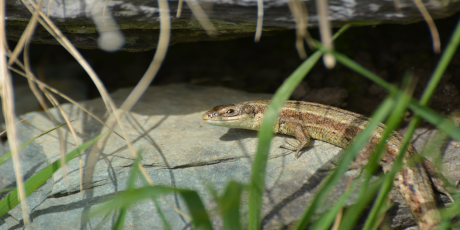Call for communities in south Kerry to contribute to wildlife research 13 May 2021

Local knowledge key to assessing status of Ireland’s only native reptile, the common lizard
The LIVE project (www.ecomuseumlive.eu), coordinated by School of Biological, Earth and Environmental Sciences (BEES)/ Environmental Research Institute (ERI), University College Cork and based on the Iveragh peninsula in south Kerry, is inviting members of the public to submit sightings of Ireland’s only native reptile, the elusive common lizard. The citizen science project hopes to gain a better understanding of how ‘common’ the common lizard is in the region and to identify trends related to where the species is present or absent. By learning more about where this species thrives and sharing information with the public, the project hopes to assist in conserving lizards in Ireland into the future.
Linda Lyne, the UCC researcher leading this initiative, says “Whether it is in your back garden or on an upland walking trail – every record counts.” She is keen to stress the value of local knowledge to her work, saying “Public contributions to nature projects are an excellent resource for data collection. Everyone who submits a record of the plants and animals around them is making a vital contribution to research and conservation.” She also intends to embark on a wider study to investigate how the species arrived in Ireland around the last ice age and to map the types of habitat where lizards are most commonly found on the Iveragh peninsula.
The common lizard is thought to occur all over the island of Ireland, but its distribution is largely unknown as records of sightings are sparse. More common in rural areas such as upland heaths, old stone walls and banks along walking trails, lizards have excellent camouflage making them difficult to spot. LIVE has created several resources to help the public identify suitable lizard habitats, tips on how to spot lizards and educational packs for families/schools. These are available on the project website: www.ecomuseumlive.eu/commonlizard.
LIVE Principal Investigator, Dr Fidelma Butler, a senior lecturer in the School of BEES/ERI emphasises that maps of the records will be publicly available in addition to educational resources for contributing communities. She says “These records will not only benefit research; they will also benefit local communities in valuing the natural capital that surrounds them. The LIVE project is extremely keen to connect academic knowledge with the knowledge of local residents and to ensure that communities benefit from our work.”
The status of the common lizard is just one of the themes being explored by the LIVE project, which is a collaboration between academic departments, community organisations and local governments on the Iveragh peninsula in Ireland and the Llŷn peninsula in Wales. LIVE aims to enable coastal communities to promote their natural and cultural assets, creating opportunities for sustainable tourism, especially outside of the traditional peak tourist seasons. The project has received funding from the European Regional Development Fund through the Ireland Wales Cooperation Programme.
Updates about the project will be available on the website and through the project social media channels.
More about the LIVE Project:
The status of the common lizard on Iveragh is just one of the themes being explored by the LIVE project, which has been co-funded by the European Regional Development Fund through its Ireland Wales Cooperation Programme. LIVE is aiming to enable coastal communities to promote their natural and cultural assets. Follow @ecomuseumslive on social media for other upcoming initiatives.
More information:
Website: https://www.ecomuseumlive.eu/commonlizard
Social media: @ecomuseumslive
Lucy Taylor – LIVE Project Manager, School of Biological, Earth and Environmental Science, University College Cork. live@ucc.ie / 087 942 8002
Useful links:
The Herpetological Society of Ireland: https://thehsi.org/native-reptiles-and-amphibians/common-lizard/
National Biodiversity Data Centre: https://maps.biodiversityireland.ie/Species/128610
Irish Wildlife Trust 2007 Survey: https://www.lacerta.de/AF/Bibliografie/BIB_4273.pdf
